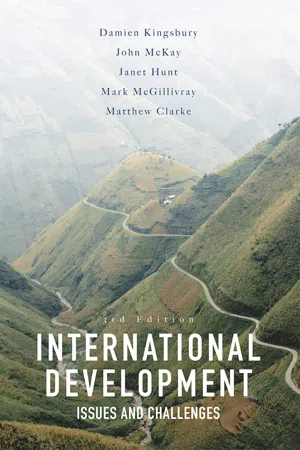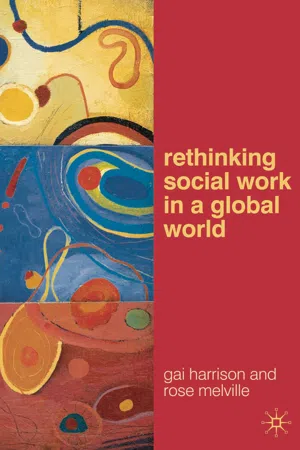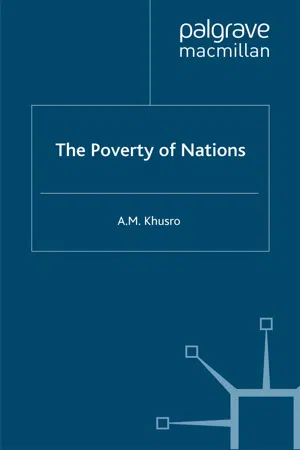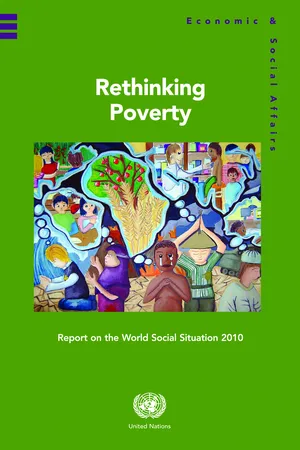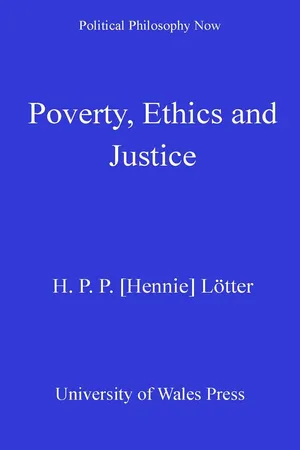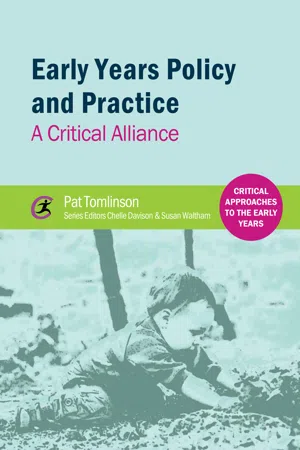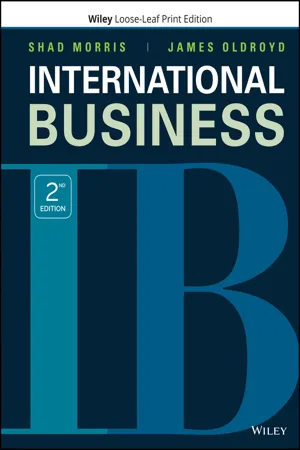Economics
The problem of Poverty
The problem of poverty refers to the widespread lack of material resources and basic necessities among a significant portion of the population. It is a complex issue with multifaceted causes, including economic, social, and political factors. Addressing poverty often involves implementing policies and programs aimed at improving access to education, healthcare, employment opportunities, and social safety nets.
Written by Perlego with AI-assistance
Related key terms
1 of 5
10 Key excerpts on "The problem of Poverty"
- eBook - PDF
International Development
Issues and Challenges
- Damien Kingsbury, John McKay, Janet Hunt(Authors)
- 2016(Publication Date)
- Red Globe Press(Publisher)
Thus, before we can eradicate poverty we clearly need to know what it is we are ending and who is Defining and Measuring Poverty 191 experiencing it as only then can we determine what sort of development interventions will be most appropriate. As already demonstrated, the most common conceptualization of poverty is the lack of financial resources – in other words, how much money you have. If we determine that having greater than US$1.25 a day is sufficient to meet basic needs, then the world has 600 million people who do not have enough money and thus live in poverty. But there are other ways to define poverty (Ruggeri Laderchi et al. 2006 ). In addition to this common monetary approach, poverty can be under-stood in terms of capabilities, inequality and social exclusion, and participation. Depending on which approach is used, those who are identified will differ, as will their number and most certainly so too will the develop-ment implementations needed to eradicate their poverty. It is useful to briefly discuss each approach before discussing some pertinent issues in greater detail. Monetary poverty Defining poverty as a lack of income is intuitively attractive. From our own personal experience, we know that money affords us the freedom to purchase both our basic needs and our desired luxuries (whether they are good for us or bad for us). In economic jargon, we increase our utility or happiness when we consume more by the simple fact that purchasing a particular commodity reveals our belief that this commod-ity will increase our utility (if the commodity will not make us happy, why purchase it?). Thus the more we purchase, the greater our utility or well-being. As a human characteristic is holding unlimited desires, increasing income therefore increases our ability to maximize our utility (i.e., purchase additional goods and services). Alternatively, having less money reduces our ability to consume and this lowers our utility. - eBook - PDF
Peasants In Distress
Poverty And Unemployment In The Dominican Republic
- Rosemary Vargas-Lundius(Author)
- 2019(Publication Date)
- Taylor & Francis(Publisher)
31 In the following, we will discuss the concept of poverty, in order to determine its relation to unemployment. 70 The Concept of Poverty Poverty is a very controversial concept. Identifying its causes and finding a generally valid definition is very difficult. In many cases, the concept of poverty is related to subjective considerations. Some consider it to be a culturally conditioned phenomenon, or a voluntary state of individual cases. Others consider poverty as the result of a downward process of circular cumulative causation32 or, as an equilibrium state sustained by the people it generates.33 But, however controversial the concept of poverty may be, very few would deny the existence of mass poverty. Most people in today's underdeveloped countries are very poor. Moreover they are also confronting increasingly deteriorating living standards.34 The characteristics and causes of poverty present a wide variation between the different underdeveloped countries. There has been a tendency to generalize on the causes of poverty. According to John Kenneth Galbraith, the causes of poverty have hardly been investigated, they have been simply assumed. Accordingly, these assumed causes of poverty became international macro level explanations such as lack of natural resources, lack of capital, the nature of government and the economic system, lack of education, intrinsic ethnic tendencies, climate, population pressure, colonialism and the specialization of underdeveloped countries as producers of raw materials and agricultural products. These arguments could be turned the other way around. - eBook - PDF
The Democratic Challenge
Rethinking Democracy and Democratization
- Jorge Nef, Bernd Reiter(Authors)
- 2009(Publication Date)
- Red Globe Press(Publisher)
Poverty, then, represents a diminished capability to live as one wants Poverty, Inequity and Democracy 109 to live and as such, it reduces the amount of freedom available to those individuals and communities affected by it. At the same time, poverty is the most visible manifestation of economic insecurity. It is often related to other symptoms such as low or stagnant growth, large and inextricable indebtedness, deteriorating terms of exchange, food scarcity, bad health, and unemployment. Many lay people and experts alike see poverty as the principal economic and social problem in the world; and the main devel-opmental challenge. Underdevelopment is much more than the size of GNP, GDP per capita or the rate of growth. It involves basically the ques-tion of “what’s happening to poverty?” (Seers, 1977). Perhaps the most ironic paradox of our time is that poverty is persisting and spreading in the most prosperous age in human history. For the problem of deprivation is not one of wealth-creation, but squarely one of distribution. Fifteen years ago, the UNDP report (UNDP, 1993) noted that the wealthiest 20 percent of humanity received 82.7 percent of the world’s income. One year later, in 1994, the last year these comparative statistics were systematically published in a comparable manner, the upper percentile had increased its share to over 90 percent. Though more recently, neo-liberal intellectu-als have made claims regarding a decline of inter-national disparities; the long run historical trends (1960–1994) are quite revealing (Dwivedi et al., 2007: 45). Also revealing is the apparent tendency for within-coun-try disparities to increase in recent years, even under conditions of appar-ent reduction of disparities among countries (Milanovic, 2006: 7). These trends point at an entrenched structural bias in the material distribution of assets and liabilities in the world system. - Elizabeth Segal, Karen Gerdes, Sue Steiner, , Elizabeth Segal, Karen Gerdes, Sue Steiner(Authors)
- 2018(Publication Date)
- Cengage Learning EMEA(Publisher)
The “multiproblem” poor, it is claimed, suffer the psychological effects of impoverishment, the “culture of poverty,” and the deviant value system of the lower classes; conse-quently, though unwittingly, they cause their own troubles. From such a viewpoint, the obvious fact that poverty is primarily an absence of money is easily overlooked or set aside. (Ryan, 1976, pp. 5–6) Ryan argues that this is how Americans accept a society that rewards some people with good jobs, safe homes, and two-parent families while others do not receive benefits. If poverty is the fault of each poor person, then others do not need to examine the way income is earned or consider whether all peo-ple have the opportunity to acquire wealth. All efforts at fighting poverty are aimed at the individual rather than at changing the economic structure. The system’s role never gets addressed, and systemic inequality continues genera-tion after generation. Copyright 2019 Cengage Learning. All Rights Reserved. May not be copied, scanned, or duplicated, in whole or in part. Due to electronic rights, some third party content may be suppressed from the eBook and/or eChapter(s). Editorial review has deemed that any suppressed content does not materially affect the overall learning experience. Cengage Learning reserves the right to remove additional content at any time if subsequent rights restrictions require it. POVERTY AND ECONOMIC DISPARITY 77 In addition, social stigma and blame enter deeply into the personal being of people who are poor. Poor people internalize this blame from a very young age, and this factor can be a challenge for social workers who try to help peo-ple move out of poverty (Ryan, 1976). The challenge is how to address inter-nalized blame (see Boxes 3.2 and 3.3).- eBook - PDF
- Gai Harrison, Rose Melville(Authors)
- 2009(Publication Date)
- Bloomsbury Academic(Publisher)
In the final section, we provide an overview of the role of social work in addressing poverty to create a more inclusive and equitable world, with particular ref-erence to the ideas of global redistributive justice and global citizenship. What is poverty? Poverty is a very complex phenomenon as well as being a socially, politic-ally and culturally contested notion. In an attempt to differentiate extreme poverty and material deprivation at a global level, the World Bank adopted 34 Rethinking Social Work in a Global World the international benchmark known as purchasing power parity (PPP). For the purposes of measuring global poverty, this gives us an indication of dif-ferences in people’s purchasing power across income groups and locations using a common currency. In 1990, the level set for ‘extreme’ poverty was US$1.00 a day, while for middle-income developing countries the poverty line was fixed at US$2.00 (Chen and Ravallion, 2007). The significance of these measures is that they are used to quantify how many people are living in poverty by calculating how many people fall below these thresh-olds. However, these benchmarks were initially set very low and did not necessarily reflect the consumption patterns and spending priorities of poor people. The international poverty line has only recently been adjusted to US$1.25 to reflect standards of living in 2005 (World Bank, 2008a). Even so, these measurements grossly underestimate the number of people living in poverty around the world (Pogge, 2004). In Western nations, poverty has been defined in various ways. The most common approach has been to use an arbitrary statistical figure – or pov-erty line – as a set minimum amount of income/expenditure. Poverty has also been conceptualized in absolute and relative terms. Absolute poverty describes the situation of people who are deemed to lack the basic resources needed to maintain health and subsistence living. - eBook - PDF
- A. Khusro(Author)
- 1999(Publication Date)
- Palgrave Macmillan(Publisher)
Part II Measurements of Poverty 4 Alternative Definitions and Measurements of Poverty Terrible poverty appears to be a universal phenomenon and it is possible to hypothesize, with some degree of credibility, that while most countries and regions of the world are experiencing an improvement in affluence to a smaller or greater extent, in virtually no country or region can the exis- tence of poverty be denied. In fact, in many parts of the world – both countries and regions – poverty seems to be on the rise, engulfing an increasing number of people or reducing the position of the poor in rela- tion to the rich. This hypothesis about a simultaneous existence of poverty and affluence in all parts of the globe, including the industrialized and highly developed nations, and an increase in poverty in many parts, in absolute, proportionate, relative or indexed terms, has to be tested and either established or rejected – wholly or partly. VARIOUS DEFINITIONS OF POVERTY Moreover, even as the meaning of absolute, proportionate and relative poverty and other concepts such as sectoral or segmented poverty would have to be established by means of rigorous definitions, the very term ‘poverty’ needs a working definition. An important aspect of poverty is a subjective feeling of being poor either absolutely or relative to others, but such a subjective definition, as distinct from objective definitions, is diffi- cult to handle. The difficulty in dealing with subjectivity – a feeling of being poor – can be understood by a classic definition of poverty attribut- able to Socrates: Contentment is natural wealth and greed is forced poverty. Since such emotions as contentment and greed are very subjective, this definition of poverty will not be pursued in this work. However, economists and social scientists have evolved a concept of deprivation which can be taken into account alongside the various objec- tive definitions. - No longer available |Learn more
Report on the World Social Situation 2010
Rethinking Poverty
- (Author)
- 2010(Publication Date)
- United Nations Publications(Publisher)
45 Chapter III The poverty of poverty measurement Measuring poverty accurately is important within the context of gauging the scale of the poverty challenge, formulating policies and assessing their effectiveness. However, measurement is never simply a counting and collating exercise and it is necessary, at the outset, to define what is meant by the term “poverty”. Extensive problems can arise at this very first step, and there are likely to be serious differences in the perceptions and motivations of those who define and measure poverty. Even if there is some consensus, there may not be agreement on what policies are appropriate for eliminating poverty. As noted earlier, in most developed countries, there has emerged a shift in focus from absolute to relative poverty, stemming from the realization that the perception and experience of poverty have a social dimension. Although abso- lute poverty may all but disappear as countries become richer, the subjective perception of poverty and relative deprivation will not. As a result, led by the European Union (EU), most rich countries (with the notable exception of the United States of America), have shifted to an approach entailing relative rather than absolute poverty lines. Those countries treat poverty as a proportion, say, 50 or 60 per cent, of the median per capita income for any year. This relative measure brings the important dimension of inequality into the definition. Alongside this shift in definition, there has been increasing emphasis on monitoring and addressing deficits in several dimensions beyond income, for example, housing, education, health, environment and communication. Thus, the prime concern with the material dimensions of poverty alone has expanded to encompass a more holistic template of the components of well-being, includ- ing various non-material, psychosocial and environmental dimensions. - eBook - PDF
- Hennie Lötter(Author)
- 2011(Publication Date)
- University of Wales Press(Publisher)
2 • Defining Poverty as Distinctively Human 1 There are lots of things one can say about poverty without fear of contradiction. Poverty is arguably the biggest problem facing humans today 2 and the greatest cause of suffering on earth. 3 Poverty is responsible for more preventable deaths than anything else. 4 We, human beings on earth, have all the knowledge and resources available we need to eradicate poverty everywhere. 5 Never before has poverty been so high on the agenda of so many governments and international bodies. The world has never before witnessed so many heads of state and governments publicly commit themselves to eradicate poverty. 6 Despite all this, poverty still persists as a massive problem affecting hundreds of millions of human beings across the globe. 7 Most of us can identify human beings suffering from poverty easily, but find it slightly more difficult to understand poverty properly. Note the following remarks by a poor Kenyan man about the visibility of his poverty: Don’t ask me what poverty is because you have met it outside my house. Look at the house and count the number of holes. Look at my utensils and the clothes that I am wearing. Look at everything and write what you see. What you see is poverty. (quoted in Narayan et al., 2000a: 30) In this respect poverty resembles the common cold. Most humans can easily and accurately observe when a fellow human suffers from the common cold, as the symptoms are clearly visible and identifiable. A further resem-blance between poverty and the common cold that will emerge later on is that both phenomena can be caused by a variety of factors. As the common cold is caused by a virus that constantly mutates so poverty results from one or more causes drawn from a wide-ranging set of factors. In this chapter I aim to deepen our understanding of poverty by interpret-ing the conventional definitions of poverty in a new light. - No longer available |Learn more
Early Years Policy and Practice
A Critical Alliance
- Pat Tomlinson, Chelle Davison, Susan Waltham, Chelle Davison, Susan Waltham(Authors)
- 2013(Publication Date)
- Critical Publishing(Publisher)
You might deliberate whether an extra pound or two in the pocket through fiscal policy alleviates relative poverty and its impact on children’s growth and development. And you may cogitate on the opacity of social exclusion. In doing so a prevailing thought might be the inadequacy of these definitions in evaluating how poverty is experienced. Critical question The context and complexity of social exclusion policy can have the opposite of the » intended effect. In relation to young children’s poverty, critically evaluate what you would include in your definition of social exclusion to determine its potential effect. What poor people say Definitions and measures of poverty have generally been devised by politicians, economists, researchers and academics of many persuasions, so in the main by those with little, if any, experi- ence of poverty other than at third hand. As such, they tend to reflect the desires and expecta- tions of policy-makers, influencers and advisers. As we have discussed earlier, the circumstances of those in poverty largely prohibit opportunity and access to such professions or status. However, there is a body of research and inquiry that is seeking to ascertain the voices of the poor (Narayan, 2000) and reflect it in analysis and policy discussion. Participatory Poverty Assessment (Robb, 2001) is a method to include poor people in influencing poverty policy and informing definitions. It uses three main approaches: 1. drawing on field research; 2. engaging with policy-makers and influencers; 3. taking account of demographic and other data of the relevant area. Synthesis of these components provides insightful and relevant discussion and development of strategies in the fight against poverty. The poor in Narayan’s (2000) field research indicated five main areas of importance to poor people. 1. Lack of material necessities. 2. Low status and powerlessness. 3. Absence of social participation and cultural identity. - eBook - PDF
- Shad Morris, James Oldroyd(Authors)
- 2020(Publication Date)
- Wiley(Publisher)
Individuals can have a significant impact on global companies by rewarding those who are actively engaged in efforts that seek to eliminate poverty. As companies, governments, and individuals come together, innovate, and create new opportunities, many people can move out of poverty, giving some hope that poverty can be eliminated. The United Nations reports that more than 1 billion people have moved out of extreme poverty, and the portion of under- nourished people in developing countries has been cut in half since 1990. 31 Summary and Case Summary LEARNING OBJECTIVE 10.1 Identify the causes and consequences of global poverty as they apply to interna- tional business. Poverty is the general scarcity or lack of material possessions or money for consumption. If the poor are boosted beyond a certain threshold, they are able to become more productive and gain wealth. Focusing on poor markets can provide unique opportunities for companies to increase profitability and competitiveness, but there are risks. LEARNING OBJECTIVE 10.2 Discuss traditional approaches to alleviating global poverty. The traditional response to poverty is the distribution of foreign aid by government aid agencies, multilateral aid agencies, and non- profit organizations. Educational institutions have recently begun studying aid distribution and effectiveness. Foreign aid can alleviate poverty, but, if not carefully implemented, it can also stifle innovation, encourage corruption at the government level, and cause dependence. LEARNING OBJECTIVE 10.3 Compare traditional approaches and business solutions to poverty. Businesses have traditionally played a role in alleviating poverty through corporate social responsibly (CSR) initiatives. But some companies have gone further and see the poor as clients or employees rather than victims.
Index pages curate the most relevant extracts from our library of academic textbooks. They’ve been created using an in-house natural language model (NLM), each adding context and meaning to key research topics.
